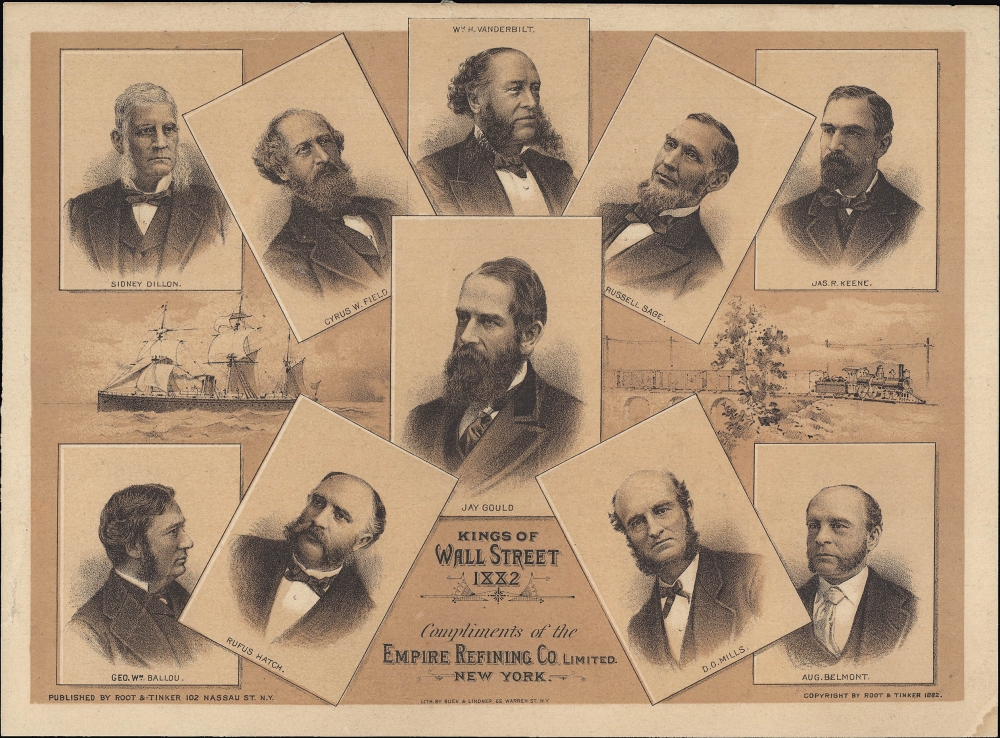1882 Root and Tinker Broadside - Gilded Age Robber Barons
KingsOfWallSt-roottinker-1882
Title
1882 (dated) 6 x 8.25 in (15.24 x 20.955 cm)
Description
A Closer Look
Composed and printed as a lithograph by the New York-based lithographers Buek and Lindner and subsequently published and distributed by Root and Tinker of Nassau Street, this 1882 broadside features ten emblazoned portraits of iconic American business tycoons. Starting in the middle of the top row and moving clockwise around the image, we find William H. Vanderbilt, Russell Sage, James R. Keene, August Belmont, Darius Ogden Mills, Jay Gould, Rufus Hatch, George W. Ballou, Sidney Dillon, and Cyrus W. Field. Though somewhat less famous now than the towering figures of the following decades, Rockefeller and Carnegie, these men were the leading financiers and robber barons of the early Gilded Age, both famous and widely reviled for their cutthroat, unscrupulous business practices.The broadside was created as an advertisement for the Empire Refining Company, a large oil refinery based in New York with works both in Greenpoint, Brooklyn, and Long Island. In addition to their refineries, Empire had oil extraction interests all over the country. In August of 1883, a year after this broadside was issued, the refinery at Hunter’s Point was destroyed by an accidental fire.
Root and Tinker Portraiture
This broadside was published as part of a flurry of celebratory advertisements produced by Root and Tinker in 1882. In addition to our broadside, they also published a chromolithograph in sepia tones, in which the same ten business tycoons sit around a table in a prominent drawing room under the portrait of Cornelius Vanderbilt. To underline the capitalist theme, the clock on the mantlepiece is crowned by a bull figurine and flanked by two chained bears. Another reminiscent piece, also published by Root and Tinker in 1882, uses the same compositional mechanism of placing a series of portraits on a thematic background. In this case, the poster celebrates America’s most prominent newspapermen, but the concept is essentially the same.Publication History and Census
The broadside is rare, as we have not been able to identify any institutional holdings of it, nor have we been able to locate other examples of it on the market. While the OCLC has two records for the chromolithograph with the tycoons around the table listed (OCLC 1025360479, 1025435939, one being the Library of Congress), no institutional holdings are listed for this print.CartographerS
Root and Tinker (fl. c. 1870 – c. 1896) was a New York City based publisher of trade journals, prints, broadsides and trade cards active in the later part of the 19th century. The company was founded by the owner of Root Newspaper Association and son of composer George Frederick Root, Charles Towner Root (November 9, 1849 - December 13, 1938), along with Franklin H. Tinker (1852 - 1890), and his father Henry F. Tinker (1826 - 1889). They initially issued journals for a variety of trades including the millinery industry, the upholstery trade, the pharmaceutical trade, and the clothing business, among others. Their broadsides reflected interests of their clientele, often extolling the heads of their respective industries. They often worked with Buek and Lindner lithography to engrave and print their publications. The firm reached its height in the 1880s, but with the death of Henry Tinker in 1889 and his son, Franklin Tinker, in 1890, the firm shifted focus. While Root, now a sole owner, continued to publish under the Root and Tinker imprint into the early 1890s, he had other visions. In 1889, Root and Tinker good over the retail trade journal, Dry Goods Economist. The publication was geared towards department store managers and proved highly influential in developing American merchandising theory. In the early 20th century, Root took the firm in yet another new direction with a focus on textile printing, renaming Root and Tinker as the 'Textile Publishing Company.' Shortly there after the name changed again this time to 'United Publishers.' He continued to manage the company until he retired in 1924. By this time Root had acquired great wealth, owning elegant mansions in New Jersey and Maine, as well as a grand townhouse, which still stands, at 309 West 92nd Street in Manhattan. More by this mapmaker...
Gustav H. Buek (August 20 1850 – February 8, 1927) was an American lithographer of German descent active in the latter part of the 19th century. Buek was born in Boston, Massachusetts and moved to Brooklyn, New York as an infant, where he lived the rest of his life. He apprenticed with Hatch and Company, Lithographers of New York. After his apprenticeship, in 1866, he took work with Donaldson Brothers, for whom he headed their art department. In 1881, partnering with F. H. Linder, he founded the firm of Buek and Linder with an office at 65 Warren Street, New York. Linder retired in 1884, after which Buek changed the name to G. H. Buek and Company and took on a new partner, Léon Marié. They also moved to more spacious office at 146-150 Center Street. In 1891, G. H. Buek and Company they merged with the American Lithograph Company. He is credited with being the first to introduce facsimile watercolor work to commercial lithography. Buek was a member of New York City's Salmagundi Club. At the time of his death, Buek was also the president of the Alco-Gravure Company, which printed gravure sections for twenty-seven newspapers across the United States. After suffering from poor health for several years, Buek journeyed to New Mexico with his wife and a nurse in the hope that climate would improve his condition. Unfortunately, his condition did not improve and he died in Albuquerque. Buek was also a noted art connoisseur and philanthropist. His 'remarkable collection' included paintings, china, and glassware. Buek married his wife Louise Valentine in 1873 and they were married for fifty-four years. Learn More...

